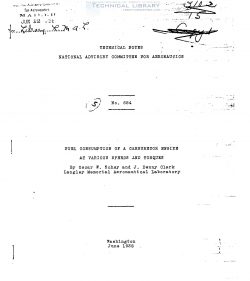naca-tn-654
- Version
- 140 Downloads
- 768.15 KB File Size
- 1 File Count
- November 28, 2016 Create Date
- November 28, 2016 Last Updated
National Advisory Committee for Aeronautics, Technical Notes - Fuel Consumption of a Carburetor Engine at Various Speeds and Torques

An investigation was conducted to obtain fuel—con—
sumption curves for a single-cylinder engine with a Wright
1820—G and a Pratt & Whitney 1340—3 cylinder at varying
speeds, manifold pressures,-and air—fuel ratios. The
1340-3 cylinder was tested at speeds from 1.200 to 2,400
r.p.m. and at manifold pressures from 21 to 38 inches of
mercury absolute. Less extensive tests were made of'the
1820~G cylinder.
The results of the tests showed that the minimum
brake fuel consumption was obtained when the engines were
operating at high torques and at speeds from 60 to 70 per-
cent of the rated speed. The fuel consumption increased
at an increasing rate as the torque was reduced; and, at
45 percent of maximum torque, the fuel consumption was 20
percent higher than at maximum torque when the engines
were operating at 70 percent of rated speed. Minimum spe—
cific fuel consumption was obtained at the same air—fuel
ratio regardless of compression ratio. No improvement in
fuel consumption was obtained when mixtures leaner than an
air-fuel ratio of 15.5 were used. The leanest mixture ra—
tio on which the engine with the 1340- H cylinder would op—
erate smoothly was 18. 5 and the spark advance for maximum
power with this mixture ratio was 50° 3. T. G. A method is
discussed for reducing the amount of testing necessary to
obtain curves for minimum brake fuel consumption.
The fuel consumption of an aircraft engine is an im-
portant consideration,'especially if the engine is used
in long—range aircraft. Even the most efficient engines
will consume their weight in fuel in 3 to 5 hours of flying
depending on what percentage of-the total power is being
used.
During-the past few years a large improvement has
been made in the fuel consumption of aircraft engines.
This improvement has resulted principally from the fact
that better cooling of the cylinders and valves and the
availability of fuels of high antiknock value make it pos—
sible to operate at_higher compression ratios and with
leaner mixtures. Increased cylinder turbulence and more
uniform mixture distribution have also resulted in reduced
fuel consumption. Automatic mixture controls and mixture-
strength indicators are being used to assure that_economi-
cal operation is maintained in flight. These devices are
very essential when constant—speed propellers are used be-
cause the pilot cannot lean his mixture to the point where
the engine speed starts to fall off and then enrich the
mixture slightly, as is the practice when fixed—pitch pro—
pellers are used. The mixture-control and indicating de—
vices serve to establish the most economical mixture set»
ting for a particular speed and manifold pressure_but not
the most economical engine operating condition. The engine
speed and the manifold pressure fon_the most economical op—
eration must be determined by testing the engine.
| File | Action |
|---|---|
| naca-tn-654 Fuel Consumption of a Carburetor Engine at Various Speeds and Torques.pdf | Download |

Comment On This Post